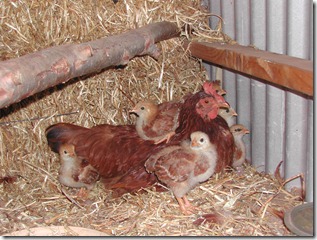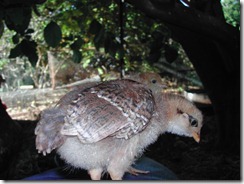Companions in the veggie garden
Circa December 2004, from the book Tales of a Backyard Farmer
Gardening would be a solitary activity if it were not for the birds – these keep one company and provide an endless source of fascination. In an organic vegetable garden, birds (with a few exceptions) are welcome workers that balance the insect pressures on the growing plants  in return for food and lodging. One of the mysteries of this garden is where all these birds spend their nights – when it comes time to roost they do so very quietly and secretively so as not to alert predators. All this mysterious activity occurs when I am putting away my gardening tools and heading up to the house, tired and thinking of tea, and no longer tuned in to my avian friends. So many observations of the wildlife in the garden are accidental, yet made possible by staying alert (earlier in the day!) to events around me as I lay down mulch, pull weeds, tie up the tomatoes or plant out seedlings.
in return for food and lodging. One of the mysteries of this garden is where all these birds spend their nights – when it comes time to roost they do so very quietly and secretively so as not to alert predators. All this mysterious activity occurs when I am putting away my gardening tools and heading up to the house, tired and thinking of tea, and no longer tuned in to my avian friends. So many observations of the wildlife in the garden are accidental, yet made possible by staying alert (earlier in the day!) to events around me as I lay down mulch, pull weeds, tie up the tomatoes or plant out seedlings.
Some of my feathered companions are gregarious and forthright. Young Blackbirds in their grey school uniforms seem particularly fearless – perhaps this fearlessness wears off after a few close encounters of the worst kind with the feral cats that wander the district looking for an unwary meal. Each Spring brings me a new friend who follows behind me in the garden, working over newly weeded patches and picking up worms, slaters beetles and other insect disturbed by my activities.
 Some birds I have only ever heard until recently, such as the “whoo-whoo” of the Boobook owl on still nights. And then one evening I came home after dusk and was putting my bicycle in the back shed when an owl dropped over the roofline and passed just a metre or two above my head on silent wings. It’s hard to say which of us was more surprised. At times I have heard three of these owls calling from neighbouring gardens in the dead of night. As the only resident carnivores, I count on them to go after the rats that nibble off the thick skins of my lemons. Willy-wagtails also sing at night-time, and I’ve heard White-backed Magpies carolling in the pre-dawn hours of nights when the moon is full. Many birds just pass over, such as pairs of snow- white Corellas, who look like their larger cousins the Sulphur-crested Cockatoos, but without the yellow crest. They sport pink eye-patches like rogue clowns, and have long curved beaks.
Some birds I have only ever heard until recently, such as the “whoo-whoo” of the Boobook owl on still nights. And then one evening I came home after dusk and was putting my bicycle in the back shed when an owl dropped over the roofline and passed just a metre or two above my head on silent wings. It’s hard to say which of us was more surprised. At times I have heard three of these owls calling from neighbouring gardens in the dead of night. As the only resident carnivores, I count on them to go after the rats that nibble off the thick skins of my lemons. Willy-wagtails also sing at night-time, and I’ve heard White-backed Magpies carolling in the pre-dawn hours of nights when the moon is full. Many birds just pass over, such as pairs of snow- white Corellas, who look like their larger cousins the Sulphur-crested Cockatoos, but without the yellow crest. They sport pink eye-patches like rogue clowns, and have long curved beaks.
Something extraordinary happened in the garden last spring – I heard an unfamiliar bird cry overhead while cleaning up after our latest efforts at chook-house evolution.This is a pass-time that involves me in endless discussions with my youngest son on esoteric questions like “Why don’t chickens fly?”  With all this brainstorming going on, it was hard to keep an ear out to the activities of other less lumbering birds. Yet strange cries from high up in the blue skies over the garden drew my gaze to a sight I’ve only ever seen before in the bush – a large Wedge-Tailed Eagle being pursued by a crow. I’ve seen this activity repeated with other Raptors (birds-of prey) being chased by Noisy Miners, Magpies or Magpie-Larks. These small birds chase the intruder out of range of their nests, then circle back into their home territory. They can’t frighten these big eagles, so they seem to depend on annoying them away. My theory is that they do this by flying just above and behind the eagle, disturbing the airflow over the bigger bird, making its flight awkward and clumsy and so diverting its sharp vision away from possible meals below.
With all this brainstorming going on, it was hard to keep an ear out to the activities of other less lumbering birds. Yet strange cries from high up in the blue skies over the garden drew my gaze to a sight I’ve only ever seen before in the bush – a large Wedge-Tailed Eagle being pursued by a crow. I’ve seen this activity repeated with other Raptors (birds-of prey) being chased by Noisy Miners, Magpies or Magpie-Larks. These small birds chase the intruder out of range of their nests, then circle back into their home territory. They can’t frighten these big eagles, so they seem to depend on annoying them away. My theory is that they do this by flying just above and behind the eagle, disturbing the airflow over the bigger bird, making its flight awkward and clumsy and so diverting its sharp vision away from possible meals below.
Vegetables have got their companions too, and so planning a garden is like being a social hostess – there are all sorts of rules to follow to ensure that dinner is a success (my dinner, that is!) Parsley likes partial shade, so I plant this below the giant fern-like fronds of the asparagus, whose company they enjoy, while keeping it well away from mint. I plant basil, carrots and celery between the tomatoes, but keep the potatoes and fennel away from them. The carrots grow well in the company of onions, so they make a good border between the onions and beans, which do badly if placed together. I often plant leek and carrots together. The beans get on with the potatoes, so they can be side-by-side or interspersed, especially broad beans and potatoes, which share the winter veggie garden. The potatoes and pumpkins are mutually hostile, while the corn and pumpkins enjoy being together. Coriander and dill are two herbs that can be mixed, where the dill can lure pests away from the carrots and tomatoes. I plant African marigolds in among the lettuces, and enjoy their deep orange and yellow blossoms among all the green, and their pungent odour. This year I’ll plant out a few more, near the tomatoes and potatoes.
Nasturtiums also have pretty flowers that add something to the contrasting greens of the veggie crop, and keep aphids away from the zucchini. Both are rampant growers, so I put them in a corner and let them fight it out. Basil I grow everywhere – both the bees and I love it. Last year I grew some of the dark ruby basil as well as the sweet basil that we use for pesto in pasta, and for sprinkling fresh on tomatoes and sliced bocconchini cheese in olive oil dressing.
Lots of plants (with the exception of rue) go well with cabbage – beans, beetroot, celery, chives, sage, onions and leeks – so they are easy to find partners for. The cucumbers are similarly gregarious in summer, so can be placed near the beans or lettuce. All these relationships result in much head scratching and scribbling and crossings out as I plan the spring crop. The short answer to all this complexity is to get a book and keep cross-referencing one crop against another. My favourite is Brenda Little’s “Companion Planting in Australia”.
Arranging bedfellows is only half the job. One has to have a good memory for last year’s arrangements as well. The solanums (tomatoes, egg-plant and capsicums) shouldn’t occupy the same bed until three years have passed, so they have to be kept moving like vagrants or catch last year’s diseases. Peas and beans are a good follow-on crop to the gross feeders like sweet-corn, as the legume family can put much needed nitrogen back into the soil. In the third year, root crops like carrots and turnips with gentle appetites can occupy the beds. To rejuvenate the beds, I grow green manure crops like Clare sub-clover, which I slash with the whipper-snipper in spring and dig in. Or I add some compost from my precious store, built up from the shredded remnants of last years plants and chicken manure mixed with straw from the floor of the chook house, where my half-dozen hens have finished off our kitchen scraps and produced my breakfast eggs.
Very few of us are as young as we once were, and I’m no exception. So I surreptitiously look for ways to extend my tea breaks from the garden and get my hands on another piece of fruitcake. Sitting at the kitchen table mulling over my crop rotations and matchings is a great way to be gardening without effort, while my mutterings give the impression of great labour.






0 comments:
Post a Comment